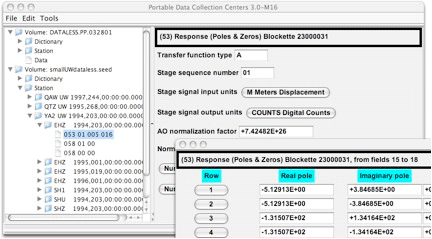Portable Data Collection Centers
The Java Path to Building SEED Volumes
The third generation of the PDCC application has been in development for the past several years. It started life as a core SEED processing library written in Java, called JavaSeed. It then expanded into a GUI application that provided the user with the ability to read in SEED volumes and edit its contents, ultimately writing out new SEED volumes that the user has authored. In the course of its evolution, PDCC has matured to allow database persistence, disk caching of work volumes, and reading of waveform records.

The earliest uses of PDCC v3.0 has been to create and maintain dataless SEED headers, which is the metadata expression of station and channel information in SEED format. With this information, a network operator can open up a data feed to IRIS DMC to transfer their data holdings for permanent storage and public access. The network operator only needs to update the SEED metadata when new stations are added or when station configurations change. The PDCC tool facilitates these updates by allowing the user to edit SEED header contents and save them as database entries or new SEED files.
More recent functionality in PDCC has been the support of waveform records, where the user can read in a full SEED file, or miniSEED data, and examine the header contents. Minimal editing of the header is allowed, but the complications of processing data records means that new tools still need to be added over time to support the writing of data records.
In addition to SEED output, PDCC can also export to RESP file format and SAC format. RESP files can also be used as input to PDCC to serve as a response template for new station entries. As response coefficients tend to be the most tedious part of data entry for SEED header information, copying tools and columnar text file importing tools have been supplied to make the process of bulk entry much easier.
It should be emphasized that PDCC is designed for the long haul. Users that set up a MySQL database on their system can quickly make use of PDCC’s ability to synchronize information to the database, which can be drawn back for later retrieval and editing. Another feature is PDCC’s persistent disk cache, which stores the user’s latest edits on disk and is automatically reloaded when the user starts PDCC up again.
PDCC is entering production release in conjunction with the 2006 Data Management Workshop in Brazil. An announcement of the release will be sent via the software-info mailing list for interested users to download for free. PDCC is open-source and free for use under the LGPL license guidelines.
More information
by Rob Casey (IRIS Data Management Center)






